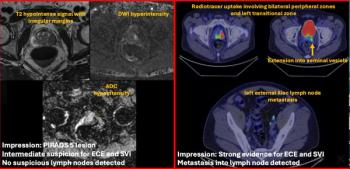
Wireless computers may bringpatient images to bedside
Palmtop computers represent the ultimate in mobility. GE Medical Systems and Siemens Medical Solutions have taken a stab at turning their potential into reality.GE is developing the eNTEGRA PE. The work-in-progress displays medical images and patient
Palmtop computers represent the ultimate in mobility. GE Medical Systems and Siemens Medical Solutions have taken a stab at turning their potential into reality.
GE is developing the eNTEGRA PE. The work-in-progress displays medical images and patient data on a Compaq iPAQ pocket PC. The palmtop interacts with the company’s eNTEGRA workstation, which prepares the data for viewing.
Being wireless makes the eNTEGRA PE extremely flexible. The device can display saved screens from any computer and for any imaging modality, including .tiff and .jpeg files. Although not useful for diagnosing-resolution is only 320 × 240 pixels-the images can be used to educate patients about their condition or to identify clinical areas of concern for referring physicians. Because the database is accessed on the main server, the PE’s limited memory-64 MB of RAM-is inconsequential, according to the company. Memory is adequate to call up most studies, said Lonnie Mixon, GEMS Americas’ marketing manager for nuclear medicine and PET.
“Anything high resolution has to be zoomed,” Mixon said. “But the device also has some nice proprietary software that has been designed and optimized by GE specifically for this application to enhance the ability to view on a small display.”
Despite limitations, there has been interest in the device.
“In discussions on PET with the physicians I’ve shown it to so far, they’ve expressed some excitement about the ability to quickly review results,” said Kevin Boyle, manager for GE’s nuclear medicine workstations. “Since it’s wireless, they can access their system from beyond the department walls (within the 600-foot radius of the transmitter). It also has its own memory, so you can take those studies to review with a patient.”
The ability to access data remotely is important because physicians can use the device on rounds. Mixon said radiologists would not want to do their final readings at bedside.
“But it can free them from the reading room so that they can talk about the results to referring physicians when they bump into them,” said Mixon.
GE expects to begin shipping the device in early 2002. Details of its commercial release have not been determined.
Siemens is also developing a handheld device for reviewing patient data. The company has crafted software called Clinical Summary that runs on a palmtop. The technology cannot handle images, and the ability of more advanced technology to do so remains uncertain, said Kevin O’Rourke, an advisor in the clinical solutions department.
The device’s low display resolution makes viewing images impractical, he said. Although future-generation systems may provide clinical images, Siemens is not actively developing image display for handhelds. So far, physicians haven’t demanded the capability.
The device, which was released commercially last December, turns an ordinary handheld computer into a mobile patient information tool. Patient medical information is available virtually any time by downloading data using a cradle attached to a networked PC, ethernet local area network, or wireless LAN, or by beaming the report to a palmtop using an infrared port.
“For Siemens, this is the first handheld of its kind,” O’Rourke said. “It’s the first handheld product to be targeted for physician use while they’re on their rounds.”
Newsletter
Stay at the forefront of radiology with the Diagnostic Imaging newsletter, delivering the latest news, clinical insights, and imaging advancements for today’s radiologists.




























